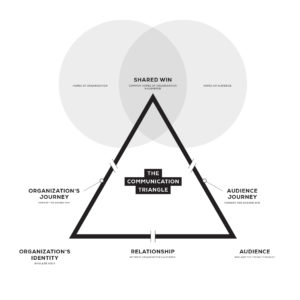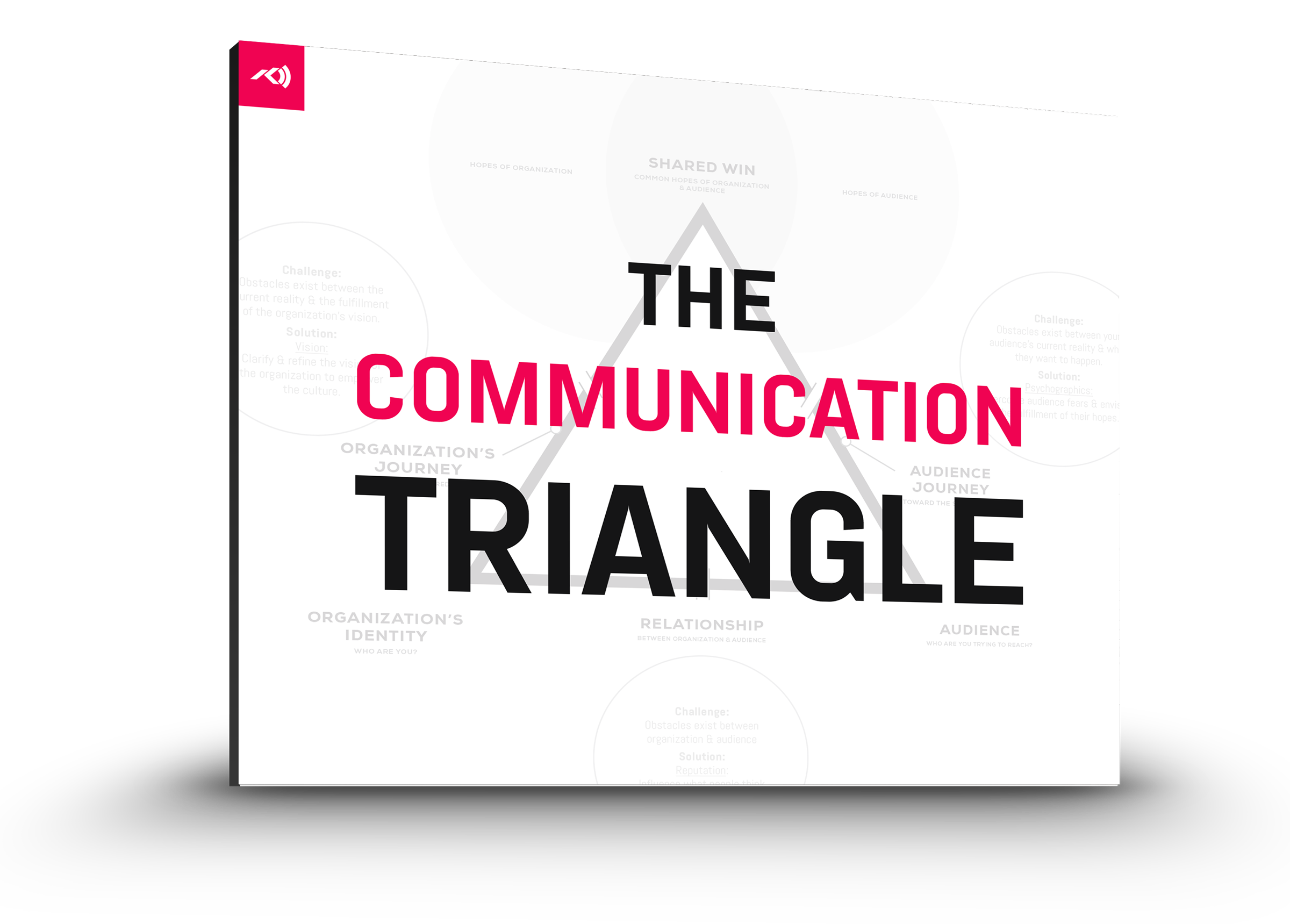
What is a brand strategy, and why do you need one?
If you want to reach more people, build healthy momentum, and create an effective brand, you need a brand strategy.
By: Laura Lopez | Branding
When your decisions are guided by a clear brand strategy, you get traction, reach the right people, and make decisions faster and more confidently. Without it, your communication is just noise, at best. At worst, you end up reaching people who don’t value you or what makes you unique.
But when you lead with a strategic plan, your message lands. Your audience is moved to action, and you move the needle forward.
The difference between brand and brand strategy
First, let’s clarify what we mean by brand. Brand is not your logo or your name. It’s not even your identity. Brand is the interactive relationship between you and your audience.
As an organization, you want to own a certain kind of relationship with your audience. Lindsay Pedersen, author of Forging an Ironclad Brand: A Leader’s Guide, calls brand “the intentional leader’s North Star.”
What does the North Star do? It stays fixed in the sky while everything else moves. It guides and gives direction. In terms of brand, a north star helps you stay on course, directs everything you communicate, and acts as a framework for measuring decisions.
If brand is a relationship, branding is the collection of elements you use to clearly communicate your brand to people. It is also the process of arriving at the logo, colors, fonts, and language you’ll use to communicate.
So, if brand is a relationship and branding is the elements of communication, then what is a brand strategy? A brand strategy is the game plan for communicating your message to your audience.
A brand strategy does these:
- Outlines who you are, who you want to reach, and what the shared win is between you and them
- Defines why you’re different from other alternatives in your competitive frame of reference
- Tells you what your brand’s creative needs to accomplish to reach your audience
- Unites your messaging and visual identity under the same strategy
Your brand strategy arises from the three components of the communication triangle:

- You: who you are, what you value, and what you offer
- Your audience: who you’re trying to reach and what they care about
- The shared win: the benefit your audience gets from connecting with you, and what you get when you serve them well
With the communication triangle as the basis for a brand strategy, you can align your communication, attract the right people, and build trust.
Why you need a brand strategy
Too many organizations speak before they think. They communicate without a strategy and often experience growth in the beginning.
Then, one day, things that once worked simply don’t work anymore. They lose momentum, and growth stops. They say things like these:
- “We’re not reaching the right people.”
- “The people we’re reaching don’t value what we do.”
- “We’re tired of guessing what will work and what won’t.”
When that happens, it’s not time for new tactics. It’s time to back up and build a brand strategy.
Brand strategy is how you stop chasing and start attracting. Without it, you’re just offering the bare minimum, and people will treat you like a commodity.
That’s because you’re not just competing with others in your space. You’re also competing with complacency and convenience. Meaning the alternative to choosing your organization isn’t always choosing a different organization—it’s also doing nothing.
But with a brand strategy, you can own a space in your audience’s mind, align your team around a shared story, and make intentional decisions that help you grow. What is a brand strategy? Your compelling edge in a noisy world.
A great example of this is Parable Accounting and Bookkeeping for Churches. Their whole brand is built around one idea: helping churches keep their dollars on mission. That one message fuels everything they say, write, and create. They don’t have to yell to get attention—they’re speaking the exact language their audience came to hear.
Brand Focus
This is the core of your brand strategy. What’s the one thing you do best, that your audience needs most, that no one else does quite like you?
Not just a strength. Not just a need. But the intersection of the two. That unique, specific space only you can own. That’s your shared win.
It’s not about listing everything you offer. It’s about naming the one thing that differentiates you and creates a lasting impression in your audience’s mind. Be assertive. Be specific. Eliminate everything that’s not you.
Ace Hardware is helpful. Volvo is safe. These brands are remembered in a single word because their focus is that clear. Your shared win should be just as sharp-edged, just as sticky.
Brand Strengths
Brand strengths, often called “brand pillars” or “reasons to believe,” prove your brand focus. You can’t just say you’re the best. You have to show the receipts.
Your brand strengths are the three to five pillars of your strategy: the things you offer that make your brand focus believable and compelling to your audience.
Brand Personality
What is a brand strategy without a personality?
People don’t just connect with what you do—they connect with how you do it. The flair you bring is part of what sets you apart. Are you a rebel? A guide? A mentor? A creator? How do you want to be perceived? Identifying your brand archetype is key to the process.
But it’s not about being cute—it’s about being consistent. If everyone else in your space is buttoned up and serious, maybe you show up as warm and witty. (Just make sure you can back it up.)
Converge Southwest does a really good job of this. They serve people who set the stage for transformation in an area that includes Hollywood, so we chose the Film Director/Connector as their brand personality. What does a film director do? Works behind the scenes, puts the right people in position, and sets the stage for them to do what they do best.
Converge Rocky Mountain is another great example of a spot-on archetype: the Trail Guide. They serve pioneering pastors and planters in the Rockies who understand the terrain, find needed resources, and navigate the landscape so they can lead more people.
Audience
“Everyone” is not a target audience. There, we said it. We know you want to reach everyone, but to do so, you have to pick someone.
Reaching everybody by picking somebody works. Why? When you find your target audience and tailor everything you say and do to appeal to them, you end up reaching more people.
To establish your target audience, start by defining them archetypally with psychographics (who they are, their shared traits, values, interests, lifestyles) and demographics (ages, ethnicities, economic statuses, life stages). Then, create specific audience personas that represent the ideal person you want to reach. This process reveals two things: are you trying to find an underserved audience, and are you being realistic?
NewGround had a target audience—presidents of financial institutions and CEOs—and decided they needed to expand to reach leaders in other verticals. They wanted to reenvision the person who would be the biggest win for them, so we helped them identify and define their audience of Groundbreakers: transformational leaders who value what NewGround values.
Result
This is where brand strategy comes full circle. You identify the functional and transformational outcomes your audience gets from choosing you. Without this, you can’t measure success.
How are their lives better? How does your brand become the solution to their challenges? You show up with a promise. They walk away with a result. And it makes them want to keep choosing you. That’s a vibrant relationship.


Download: The Communication Triangle
Can people hear what you communicate?
If you are trying to do deep, spiritual, life-changing work in people's lives, your message is critical. It has the power to revolutionize lives now and for eternity.
What’s next?
With brand strategy in place, now you can do these:
- Write messaging that’s sharp, true, and sticky
- Build a visual identity that speaks without words
- Create a website that tells the right story
- Launch marketing efforts that do the heavy lifting
- Align your internal team on the marketing plan
Remember that everything flows from your brand strategy. It works like a filter through which you can run all your communication. And it helps you and your team know what to say yes to, when to say no, and how to stay aligned no matter how big you grow.
When do you need to refresh your brand strategy?
Does a brand strategy have a shelf life? The answer is yes, sort of.
Your brand strategy should last three to five years, but that’s not carved in stone. Things change. You change. The people you’re trying to reach change. When that happens, you don’t throw your strategy out. But you do refresh and refocus it.
Keep the foundation, tweak the focus, adjust the message. It’s still your north star. Because what is a brand strategy if not a living, breathing framework that evolves with you?
Even Starbucks had to refocus. When craft coffee exploded, their brand strategy stopped working. They had to ask “Who are we now?” and shift accordingly. Given time, we’ll see how their new brand strategy holds up.
What is a brand strategy? The key to reaching more people
If you want to reach more people, grow your organization, and deliver on your mission, build your brand strategy.
Don’t know where to start? We can help.
Through deep discovery, we can help uncover who you are, who you’re for, and what you promise. We can create a brand strategy you can build around. With it in place, you’ll be positioned to move forward with clarity, confidence, and momentum.
To discuss your brand strategy, schedule a free 30-minute call with one of our consultants below.
Table of Contents
- 1. What is a brand strategy?
- 2. The difference between brand and brand strategy
- 3. Why you need a brand strategy
- 4. What are the elements of a brand strategy?
- 5. Brand focus
- 6. Brand strengths
- 7. Brand personality
- 8. Audience
- 9. Result
- 10. What’s next?
- 11. When do you need to refresh your brand strategy?
- 12. Reach more people
